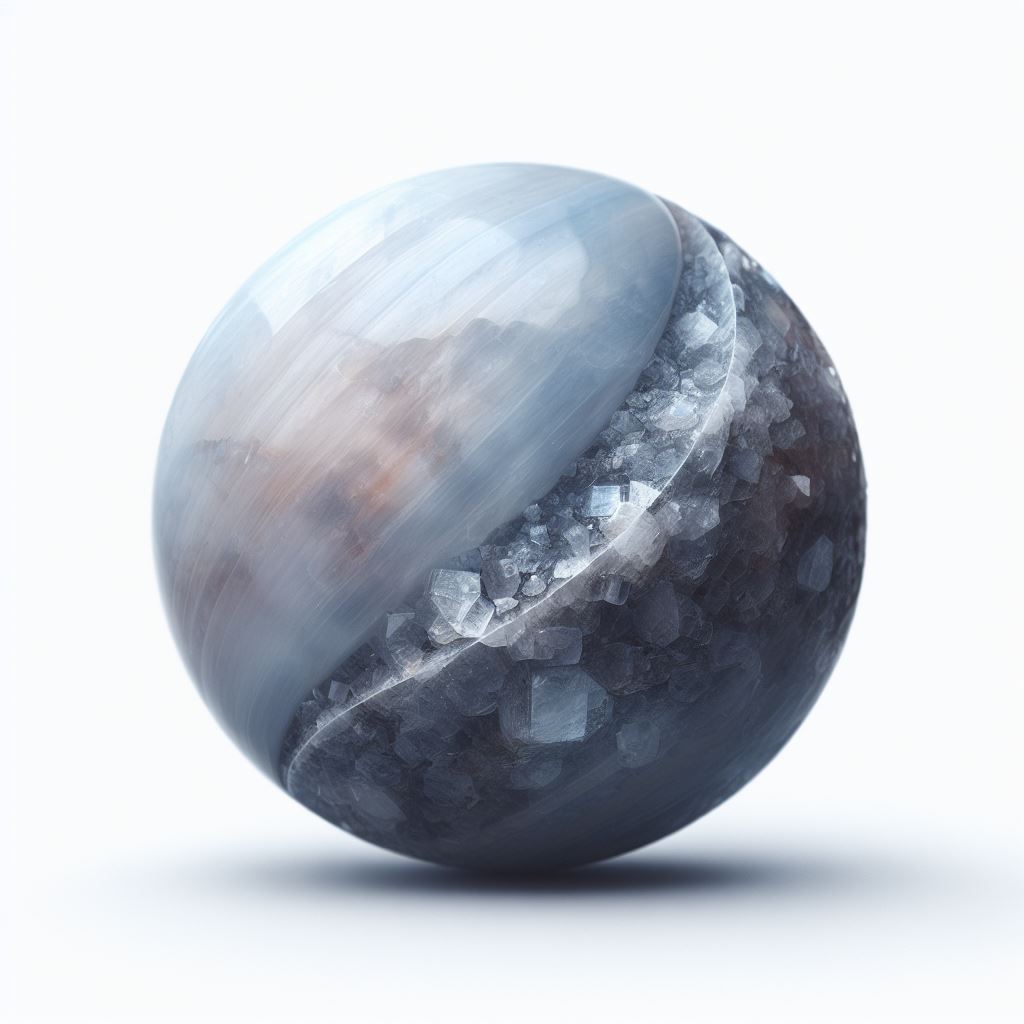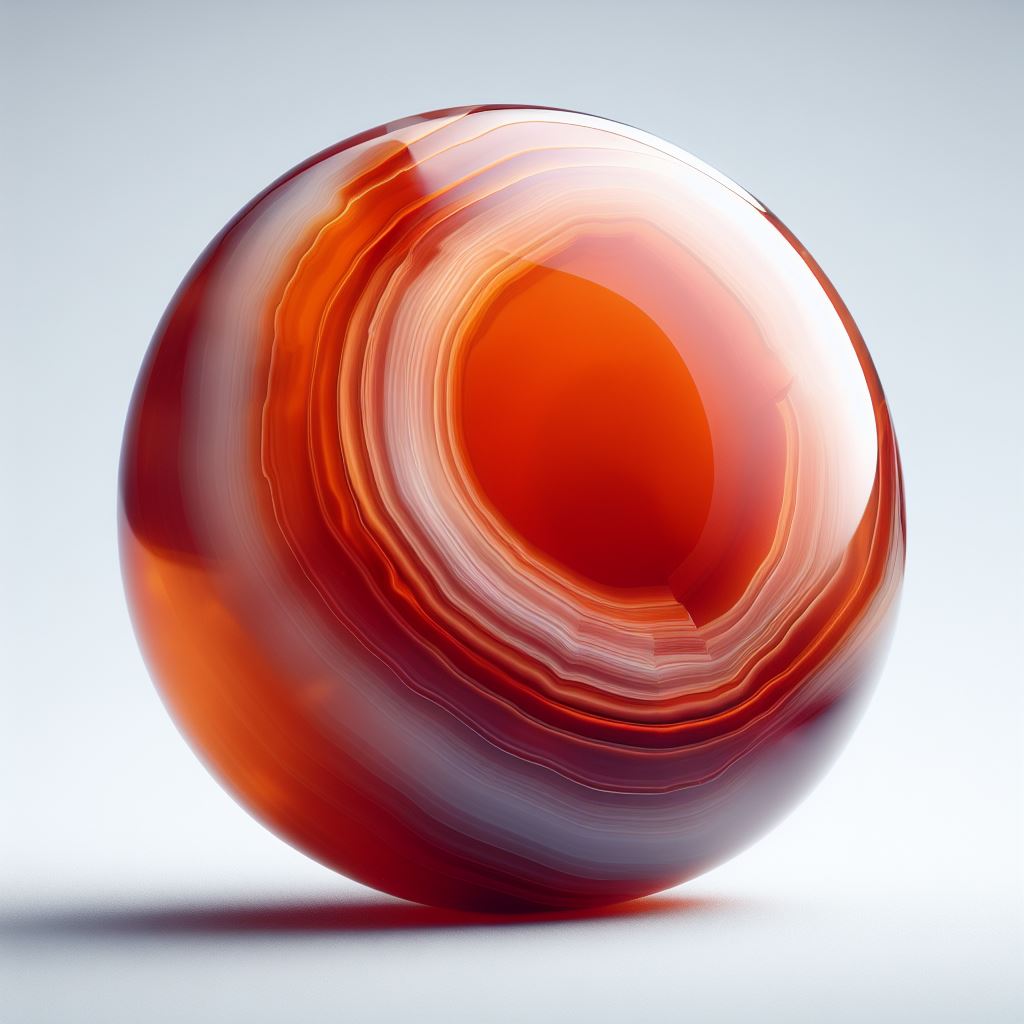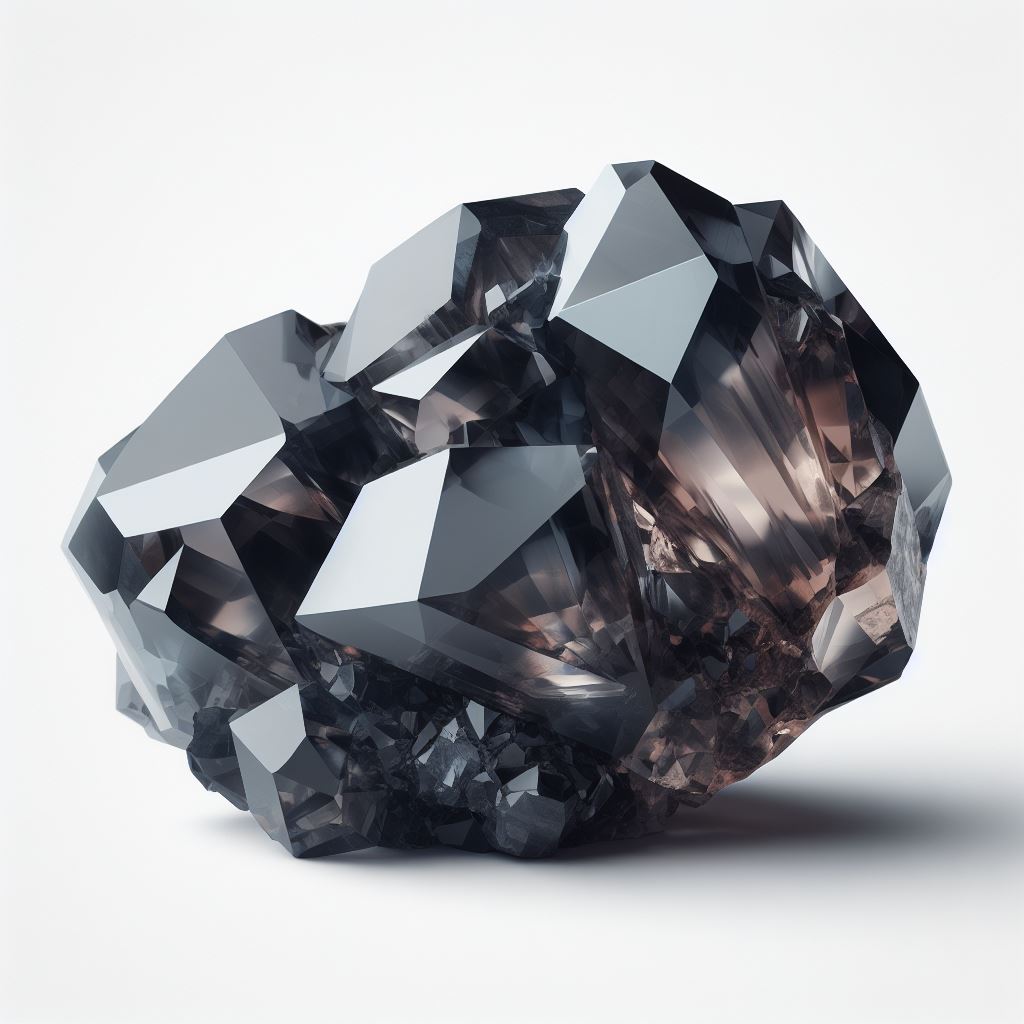Moonstone, a jewellery gemstone renowned for its enchanting play of light and mystical allure, holds a long and captivating history. This gemstone is composed of albite, plagioclase feldspar, and orthoclase feldspar. Moonstone, a type of jewellery, has a long history dating back to ancient civilizations. Treasured for centuries, moonstone is known for its unique properties and exquisite beauty. It is made up of albite and orthoclase feldspar. From the common moonstone to the rare black moonstone, this gem has fascinated cultures across the globe with its calming properties and ability to evoke love and emotions. (Keywords: love, emotions, calming) Black moonstone, also known as love stone, gets its name from its resemblance to the calming glow of the moon. This captivating gemstone has the power to enchant all who come across it. Image credit: Getty Images. Moonstone, known for its love and extra focus properties, is composed mainly of albite, a mineral found abundantly in various parts of the world.
Ancient Origins and Significance of Moonstone
Moonstone, with its rich history dating back to ancient times, is a gemstone that is loved for its beauty and mystique. This gemstone has always received extra focus due to its unique properties and allure. The love for black moonstone was highly valued by civilizations such as the Romans, Greeks, and Egyptians during the full moon. These cultures believed that moonstone possessed magical properties and associated it with lunar deities who symbolized love.
Ancient civilizations recognized the significance of moonstone and incorporated it into their daily lives. They used this enchanting black moonstone gem in various forms, including jewelry, amulets, and talismans during the full moon. Moonstone was not just seen as a beautiful stone but also held deep spiritual meaning.
The Romans considered moonstone to be a symbol of love and fertility. They believed that wearing moonstone would bring harmony to relationships and protect against negative energies. In Greek mythology, it was believed that moonstone was formed from solidified rays of the moon. This connection led them to associate the black moonstone with Artemis, the goddess of the moon.
Egyptians regarded moonstone as a sacred gem that represented divine femininity. The full moon was often used in jewelry worn by pharaohs and queens as a symbol of protection and power. The stone was also believed to enhance intuition and psychic abilities.
One of the key reasons for the continued popularity of moonstone is its historical significance. Its association with ancient cultures has contributed to its allure in modern times. People are drawn to the mystique surrounding this gemstone due to its ancient origins and spiritual connections.
Moonstone continues to be cherished for its metaphysical properties today. Many believe that it can help balance emotions, promote inner growth, and enhance intuition. It is often used during meditation or placed under pillows for peaceful sleep.
In addition to its spiritual significance, moonstone is also admired for its unique optical phenomenon called adularescence. This ethereal glow gives the stone an otherworldly appearance when light reflects off its surface.
To summarize:
- Moonstone has been highly valued by ancient civilizations such as the Romans, Greeks, and Egyptians.
- It was believed to possess magical properties and was associated with lunar deities.
- Ancient cultures used moonstone in jewelry, amulets, and talismans for protection and spiritual purposes.
- The historical significance of moonstone has contributed to its continued popularity.
Moonstone’s ancient origins and association with mystical beliefs have captivated people throughout history. Its allure as a beautiful gem with spiritual properties continues to enchant individuals today.
Cultural and Symbolic Importance of Moonstone
Moonstone holds a significant place in various cultures around the world. It has been attributed with diverse meanings, ranging from love and fertility to intuition and balance. Let’s explore the cultural and symbolic importance of moonstone in different societies.
Hindu Mythology: Divine Feminine Energy and Emotional Healing
In Hindu mythology, moonstone is closely associated with the divine feminine energy. It is believed to represent emotional healing and is often connected to the moon goddesses such as Parvati or Soma. The stone is considered a symbol of compassion, nurturing, and inner peace. Its ethereal glow is said to reflect the soothing energy of the moon, bringing calmness and tranquility to those who wear it.
Native American Culture: Sacred Stone for Good Fortune and Psychic Abilities
Native Americans regarded moonstone as a sacred stone with powerful metaphysical properties. They believed that wearing or carrying moonstone would bring good fortune and protect against negative energies. Moonstone was also thought to enhance psychic abilities, allowing individuals to tap into their intuition and receive spiritual guidance. The stone was often used during rituals or ceremonies for its mystical qualities.
Universal Appeal: Embracing Cultural Diversity
The cultural diversity surrounding moonstone highlights its universal appeal. People from different backgrounds have recognized its beauty and significance throughout history. Whether it’s the ancient Greeks who associated it with lunar deities like Selene or Artemis, or the Romans who believed it had powers of prophecy, moonstone has captured the imagination across civilizations.
Moonstone’s popularity transcends borders due to its mesmerizing play-of-color effect known as adularescence. This optical phenomenon creates a shimmering glow on the surface of the stone when light interacts with its internal structure. The enchanting colors range from milky white to blue, peach, gray, or even rainbow hues.
Today, moonstone continues to be cherished not only for its aesthetic appeal but also for its spiritual and emotional significance. Many individuals wear moonstone jewelry as a personal talisman, believing it can bring balance, enhance intuition, and promote emotional well-being.
The Evolution of Moonstone’s Popularity
Moonstone, with its mesmerizing adularescence and ethereal beauty, has a rich history that spans centuries. Its popularity has experienced various phases, reflecting the changing tastes and trends of different eras. From the Art Nouveau period to the present day, moonstone continues to captivate people with its unique allure.
Late 19th Century: A Resurgence in Popularity
During the late 19th century, moonstone experienced a significant resurgence in popularity. This coincided with the rise of the Art Nouveau movement, an artistic style characterized by intricate designs inspired by nature and fantasy. Artists and designers were drawn to moonstone for its mystical appearance and ability to evoke a sense of otherworldliness.
Moonstone jewelry became highly sought after during this period, with elaborate pieces featuring delicate settings adorned with moonstones. The gem’s shimmering adularescence perfectly complemented the flowing lines and organic motifs prevalent in Art Nouveau design. It became a symbol of elegance and sophistication.
Recent Years: A Renewed Interest in Moonstone Jewelry
In recent years, there has been a renewed interest in moonstone jewelry. This resurgence can be attributed to several factors. Firstly, moonstone’s bohemian aesthetic has become increasingly popular among fashion enthusiasts seeking unique and unconventional pieces. Its soft glow and natural iridescence add a touch of whimsy to any outfit.
Moreover, moonstone is believed to possess metaphysical properties that appeal to those interested in alternative healing practices and spirituality. It is said to enhance intuition, creativity, and emotional well-being. As more individuals explore holistic approaches to wellness, they are turning to moonstone as a talisman for balance and harmony.
The evolving trends surrounding moonstone highlight its enduring appeal across different eras. Whether it is admired for its artistic value or embraced for its metaphysical properties, this gem continues to hold a special place in the hearts of many.
Exploring Moonstone’s Historical Journey
Tracing back thousands of years, evidence suggests that moonstones have a rich history and were highly valued by ancient civilizations such as Mesopotamia and India. These mesmerizing gemstones were not only used for their beauty but also carried symbolic meanings and associations.
Ancient Civilizations’ Love for Moonstone
In ancient times, moonstones held a special place in the hearts of people. They were often carved into intricate designs or used as adornments in royal jewelry. In Mesopotamia, these shimmering stones were believed to be created from solidified moonbeams, lending them an otherworldly aura. Meanwhile, in India, moonstones were associated with the gods and goddesses of the Hindu pantheon.
The Renaissance Influence
As time went on, moonstone’s popularity spread across different regions. During the Renaissance period in Europe, it became a favorite gemstone among nobility. Its ethereal glow and captivating play of light made it highly sought after for jewelry pieces. Moonstone was often set into rings, necklaces, and tiaras worn by queens and princesses.
Moonstone Becomes a State Gemstone
Moonstone’s significance continued to grow throughout history. In 1966, it was designated as the state gemstone of Florida in the United States due to its association with space exploration. This decision reflected both its natural beauty and its connection to lunar imagery.
Associations with Lunar Cycles
One reason why moonstones have been cherished throughout history is their association with lunar cycles. Just like the moon waxes and wanes, these gemstones are said to possess a mystical energy that promotes emotional balance and harmony within oneself. They are believed to enhance intuition and provide protection during times of change or uncertainty.
Movement Across Different Regions
Moonstones traveled far beyond their origins in Mesopotamia and India. As trade routes expanded, these gemstones made their way to various parts of the world. They became highly valued in Sri Lanka, where they are still mined today. Moonstone deposits were also discovered in countries such as Brazil, Madagascar, and Myanmar.
Moonstone’s Enduring Allure
The historical journey of moonstone showcases its enduring allure and timeless appeal. From ancient civilizations to modern times, this gemstone has captivated people with its celestial beauty and mystical properties. Whether worn as jewelry or used for spiritual purposes, moonstones continue to hold a special place in the hearts of many.
Unveiling the Mystique: Legends and Lore Surrounding Moonstone
Moonstone, with its ethereal beauty and captivating glow, has long been shrouded in myths and legends. Throughout history, people have attributed magical properties to this enchanting gemstone, believing it to possess otherworldly origins and supernatural powers. Let’s delve into the mesmerizing tales that surround moonstone.
Solidified Moonbeams: A Celestial Creation?
One of the most fascinating legends surrounding moonstone is the belief that it was formed from solidified moonbeams. Ancient civilizations marveled at its luminous appearance and associated it with the mystical energy of the moon itself. According to folklore, when moonlight touched certain minerals on Earth, they were transformed into radiant moonstones. This origin story adds an air of celestial enchantment to these precious gems.
Harnessing Lunar Energies: Full Moon Magic
In ancient times, people believed that wearing moonstone during a full moon brought them good fortune and enhanced their psychic abilities. It was seen as a talisman for harnessing lunar energies and tapping into one’s intuition. During this phase of the lunar cycle, when the moon is at its brightest, moonstone was thought to amplify spiritual connections and promote inner harmony.
Divination and Protection: The Power of Moonstone
Moonstone was also believed to possess prophetic qualities, enabling individuals to predict future events or gain insight into their destiny. It was used in divination practices such as scrying or gazing into a reflective surface to seek visions or messages from beyond. This mystical gem was considered a powerful protector against evil spirits and negative energies. It was often worn as an amulet or incorporated into spells aimed at warding off malevolent forces.
Reverence for Lunar Deities: Goddess Connection
Throughout various cultures worldwide, deities associated with the moon held great significance. Moonstone became closely linked to these lunar goddesses, and it was believed to embody their divine energy. For instance, in Greek mythology, the moon goddess Selene was said to have worn moonstone as a symbol of her connection to the heavens. In Hindu mythology, moonstone represented Chandra, the god of the moon. The reverence for these lunar deities further enhanced the mystique surrounding moonstone.
A Gem of Ever-Changing Beauty
Beyond its mythical associations, moonstone’s physical characteristics also contribute to its allure. Its unique adularescence effect creates a shimmering glow that seems to move across the surface like gentle waves. This captivating play of light adds an element of magic and mystery to moonstone’s appearance.
Moonstone continues to captivate and inspire with its rich history and enchanting legends. Whether you believe in its supernatural powers or simply appreciate its beauty, there is no denying the allure and intrigue that surrounds this mesmerizing gem.
Moonstone in Different Cultures: A Global Perspective
Moonstone, a captivating gemstone, holds great significance in various cultures around the world. Let’s explore how different cultures embrace and appreciate the beauty of moonstone.
India: Sacred Stone and Traditional Jewelry Designs
In India, moonstone is considered a sacred stone with deep spiritual meaning. It is believed to bring good fortune and enhance intuition. Moonstones are commonly used in traditional jewelry designs, such as necklaces, bracelets, and rings. These exquisite pieces often feature intricate silver or gold settings that highlight the stone’s ethereal glow.
Sri Lanka: Renowned for Blue Sheen Moonstones
Sri Lanka is renowned for its high-quality blue sheen moonstones. These mesmerizing gems possess a unique optical effect known as adularescence—a phenomenon where light appears to shimmer across the surface of the stone like moonlight on water. Collectors from all over the world seek out these exquisite blue sheen moonstones due to their rarity and captivating beauty.
Australia: Ancient Connections to Dreamtime
In Australian Indigenous culture, moonstone has ancient connections to Dreamtime—the creation period of Aboriginal mythology. The stone is believed to hold spiritual energy and is associated with healing and protection. It is often used in ceremonies and rituals as a tool for meditation and connecting with ancestral spirits.
Mexico: Symbolic Significance in Folklore
In Mexican folklore, moonstone holds symbolic significance. It is associated with fertility, love, and passion. According to legend, wearing a piece of moonstone jewelry can help attract true love into one’s life or strengthen existing relationships. Moonstones are also thought to bring balance and harmony to those who wear them.
Each culture brings its unique interpretation and appreciation for moonstone’s beauty. Whether it’s India’s sacred connection or Sri Lanka’s sought-after blue sheen stones, these cultural beliefs add depth and richness to the allure of moonstone.
Moonstone’s popularity extends beyond cultural significance. Its mesmerizing play of light and ethereal glow make it a sought-after gemstone in the world of jewelry. Jewelers and gem enthusiasts alike are captivated by its beauty and versatility.
Moonstones are part of the feldspar family, specifically plagioclase feldspar or orthoclase feldspar. They are composed of layers that scatter light, creating an enchanting phenomenon known as adularescence. This unique optical effect gives moonstones their signature glow, reminiscent of moonlight shining through a thin veil of clouds.
In addition to its aesthetic appeal, moonstone is also believed to possess metaphysical properties. It is said to enhance intuition, promote emotional healing, and bring balance into one’s life. Many people use moonstone during meditation to connect with their inner selves and tap into their intuitive abilities.
Whether you’re drawn to moonstone for its cultural significance, spiritual properties, or simply its sheer beauty, this gem continues to capture the hearts and imaginations of people all over the world. Its timeless allure has made it a cherished stone for centuries.
Reflecting on the Rich History of Moonstone: Conclusion
In conclusion, the journey through the rich history of moonstone has unveiled a tapestry of ancient origins, cultural significance, and global perspectives. From its mystical beginnings in ancient civilizations to its enduring popularity in modern times, moonstone has captivated hearts and minds across cultures. Its ethereal beauty and enchanting lore have made it a cherished gemstone throughout history.
As we reflect on the historical journey of moonstone, it becomes clear that this gem holds a special place in human culture. Its symbolism as a stone of intuition, balance, and feminine energy has resonated with individuals for centuries. Whether worn as jewelry or used for spiritual purposes, moonstone continues to inspire awe and wonder.
To delve deeper into the fascinating world of moonstone, explore its diverse legends and lore or discover how different cultures have embraced this captivating gem. Let your curiosity guide you on an exploration of moonstone’s multifaceted history.
FAQs
What is the meaning behind moonstone?
Moonstone is often associated with intuition, inner growth, and emotional harmony. It is believed to enhance one’s spiritual connection and promote calmness and balance in life.
Can moonstone be worn every day?
While moonstone is relatively durable with a hardness rating of 6-6.5 on the Mohs scale, it is still susceptible to scratches and damage from harsh chemicals or rough handling. It is advisable to remove your moonstone jewelry when engaging in activities that may expose it to potential harm.
How can I care for my moonstone jewelry?
To care for your moonstone jewelry, avoid exposing it to harsh chemicals or extreme temperatures. Clean it gently using mild soapy water and a soft cloth or brush. Store it separately from other jewelry pieces to prevent scratching.
What are some popular designs featuring moonstones?
Moonstones are often incorporated into various jewelry designs, including rings, necklaces, earrings, and bracelets. Some popular styles include bohemian-inspired pieces with intricate silverwork or minimalist designs that showcase the stone’s natural beauty.
Are there different types of moonstone?
Yes, there are different types of moonstone, each with its unique characteristics. The most well-known variety is the white or rainbow moonstone, but there are also gray moonstones and peach moonstones that exhibit different hues and levels of iridescence.
Is moonstone a birthstone?
Yes, moonstone is one of the birthstones associated with the month of June. It is believed to bring good fortune and protect those born in this month.



